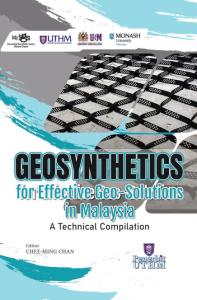Geosynthetic for Effective Geo-Solutions in Malaysia
Keywords:
advances in design, construction, applications and testing of geosyntheticsSynopsis
This is a book which gathers the best practices and research endeavours from both industry and universities in Malaysia, to showcase the advances in design, construction, applications and testing of geosynthetics in the country. The 15 chapters present interesting technical innovations in the field, refinement of the understanding in geosynthetic-soil interaction and
mechanisms, as well as geo-environmental troubleshooting and solutions. This inaugural Technical Compilation by MyIGS aims to serve as a useful guide and reference for practitioners, researchers and academics alike, to position the effective use of geosynthetics for the present, and into the future.
Chapters
-
Geosynthetic for Effective Geo-Solutions in Malaysia
Downloads
References
BS8006-1: (2021), Code of practice for strengthened/ reinforced soils and other fills, United Kingdom, London: British
Standard Institution.
Centexbel: (2014), European and international geotextile standards- a short guide, United Kingdom, Brussels:
Centexbel.
CUR (2012). Durability of geosynthetics, Publication 243, CUR Publication, Netherlands.
GRI - GCL3: (2019) Standard specification for test methods, required properties and testing frequencies of geosynthetics clay liners (GCLs) rev. 5,. USA, Pennsylvania: Geosynthetic Institute.
GRI-GM13: (2021) Standard specification for test methods, test properties and testing frequency for high density
polyethylene (HDPE) smooth and textured geomembranes rev. 16, USA, Pennsylvania: Geosynthetic Institute.
IGS (2018). Guide to the specification of geosynthetics 2018, Texas: International Geosynthetics Society.
IGS (2020). Preparing the ground for a brighter future- how geosynthetics have been serving society for half a century, Texas: International Geosynthetics Society.
ISO/TS13434: (2008), Geosynthetics — guidelines for the assessment of durability, Switzerland, Geneva: International
Organization for Standardization.
ISO10318-1: (2015), Geosynthethics-Part 1: Terms and definitions, Geneva: International Organization for Standardization.
Koerner, R.M. (2012a). Designing with geosynthetics-Vol. 1, 6th Edn. Xlibris Corporation, Indiana, USA.
Koerner, R.M. (2012a). Designing with geosynthetics-Vol. 2, 6th Edn. Xlibris Corporation, Indiana, USA.
Koerner, R.M. (2016). Geotextiles: from design to applications. Woodhead Publishing, Duxford, UK.
Koerner, R.M. and Welsh, J.P. (1980). Construction and Geotechnical Engineering Synthetic Fabrics, J. Wiley and Sons, New York, USA.
Lawson, C.R. (2008). Geotextile containment for hydraulic and environmental engineering, Geosynthetics International, 15 (6), pp. 384- 427.
Lawson, C.R. (2020). Reinforced Soil Case Studies, 2nd Edn. TenCate Geosynthetics Asia.
Lawson, C.R. (2021, April). Soft Site Impoundment Closures Using Geosynthetics’. [PowerPoint slides]. TenCate Geosynthetics Asia.
NCMA: (1997), Design Manual for Segmental Retaining Walls (DMSRW), 2nd Edn. Virginia: The National Concrete
Masonry Association.
Shukla, S.K. (2012). Handbook of geosynthetic engineering, 2nd Edn. ICE Publishing, London, UK.
Touze, N. (2021). Healing the world: A geosynthetics solution, Geosynthetics International, 28 (1), pp. 1- 31.
Yee, T.W. (2017, October) Basics of Geosynthetics. [PowerPoint slides]. TenCate Geosynthetics Asia.




